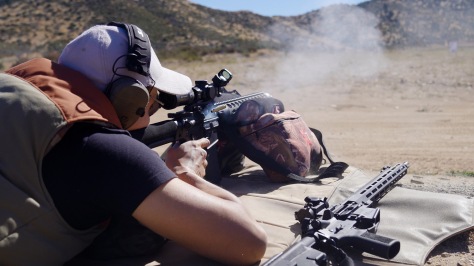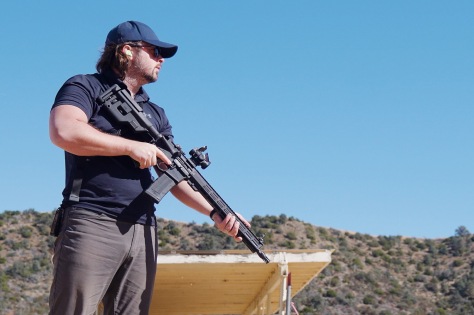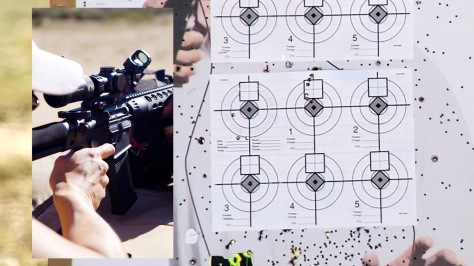Weather
Oct 27th, 2023
Temp : 60F
Humidity : Desert
Wind : 5-10mph
Notes : Sunny with a few scattered clouds
AR15 Mix and Match
The first rifle up to the line was a JP15, an AR15 variant. Mounted on top of this was a CMR8, a 1-8X second focal plane scope with 24mm objective. It’s a streamlined scope for (as the acronym goes…) close-to-medium range. The real kicker is the built-in fiber optic red dot, which holds a steady 1/2 MOA size throughout the magnification range. It’s also as bright as daylight (actually, brighter, but I’m not going to turn it up that far).

We threw a TD-3C red dot on an offset mount and stuck it toward the end of the scope. It’s not something that either of us were familiar with – offset mounting is unusual on its own, and serves a need we haven’t had. Aside from the occasional training video (or scene from Suicide Squad), I don’t think I’ve seen the setup much at all.
A second AR15 had an MM-2 dot sight on top. This one’s a little closer to a scope in form-factor, but the eye relief and overall position don’t quite match up. Easier for me to use than an open reflex sight, though! I think there’s something instinctual about lining up a tube towards the target that an open reflex sight just doesn’t do for me.

I’m typically a wood-gun shooter. If it ain’t wood furniture, it’s not really for me. An LPVO (low power variable optic) isn’t something I run often either. This day was just a whole lot of awkward situations and hunting-for-head-position. All the more reason to practice.
The Shooting
We had two targets, both at 50 yards. One was the classic paper target, covered in half-inch indicators of various sorts. The gray at the center of each circular target was a little difficult to make out around the glowing red dots. Lining up the bullseye instead took a bit of instinct and a bit of aiming by not-seeing. If I could see the bullseye, I knew I wasn’t pointed at it. If I had the bullseye perfectly covered, I could be sure it was floating just beyond the dot.

The rifles were averaging 1 MOA group sizes… with the scope. The dot sights (and their issues with precision aiming) opened the groups up a bit. In the picture just above, target #1 (the top-middle of the bottom sheet) shows two three-shot groups using the CMR8 scope. The first group was a little high, so the scope had to be adjusted down. The second group was passably close to the bullseye. Meanwhile, the sighter target (leftmost on the top row) shows a group with the dot sight. It’s about 1.5″. At 50 yards, that makes this a 3MOA group. Not thrilling, but technically on target.
LPVO vs Red Dot
Acquisition
Both red dots win by a slight margin. They’re lighter, so lifting the rifle is a touch quicker (there’s not enough difference to really matter). Eye relief is a non-factor, so they’re a bit quicker there too. And you can keep both eyes open with less strain, so target-searching is pretty fast. Personally, the MM2 is shaped in a way that I find instinctually correct.
Precision
The scope wins, hands-down. If the distance extended past 100 yards, it wouldn’t be a fair contest. This applied both to offhand and prone shooting.
Reliability
It’s a tie all the way around. Nothing broke or came loose. All adjustments were correct when made. I will add that the scope does not require batteries to still be a scope. If I’m stuck in a bad situation, I’d rather have something where batteries aren’t required.
Notes
Using a scope forces you to keep a proper cheek weld. This in turn aids with stabilizing the rifle and your torso. I appreciate that.

